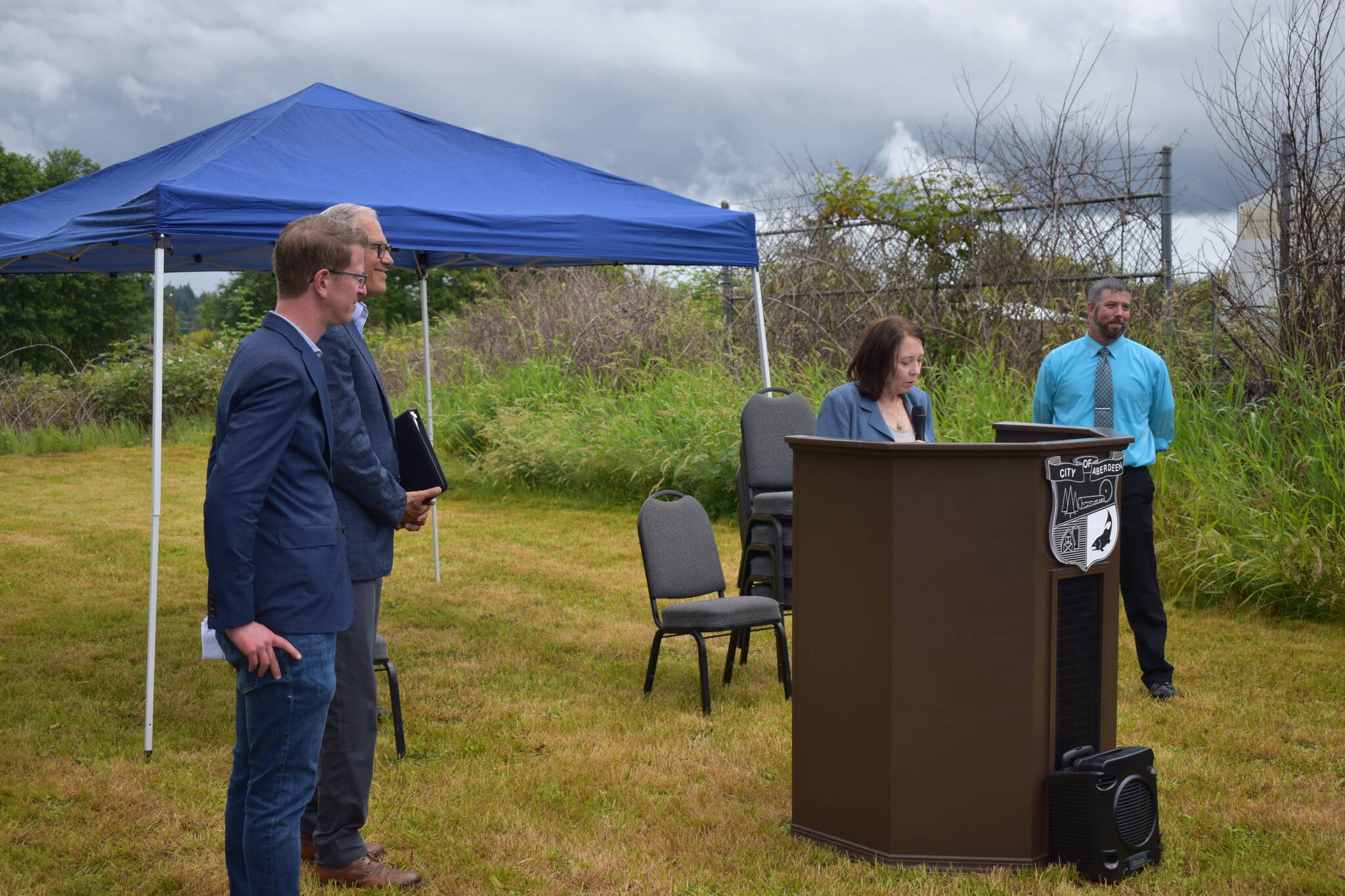The new Fry Creek Pump Station got off to a wet start on Thursday, July 7. A brief, but heavy summer rain storm had local mayors, state legislators, and other community stakeholders seeking shelter under a large tree just shy of the new pump location. But as if the weather got the memo, the rain dissipated into a tentative sunny day just minutes after the arrival of Gov. Jay Inslee.
Inslee was joined by U.S. Sen. Maria Cantwell (D-Wash.), U.S. Rep. Derek Kilmer (D-Gig Harbor) and state Senator Steve Tharinger (D-24th District) to mark the momentous occasion of the first ceremonial groundbreaking for the Aberdeen-Hoquiam Flood Protection Project.
The project is comprised of two levees in addition to the Fry Creek Pump Station: the North Shore Levee and the North Shore Levee – West Segment, which will protect Aberdeen and Hoquiam, respectively.
The levees, located along the Wishkah, Hoquiam, and Chehalis rivers, will protect against coastal flooding and bring thousands of properties out of a Federal Emergency Management Agency (FEMA)-drawn flood plain. Being in a flood plain forces property owners to abide by National Flood Insurance Program building codes and flood insurance regulations, which currently cost Aberdeen and Hoquiam residents more than $2 million in flood insurance a year.
“More than 10 percent of Grays Harbor’s population lives in this flood plain, and local residents and business owners have faced these difficulties … You can’t reinvest, you can’t develop, you’re basically stuck in the flood zone and it has major impacts on what you can do as a community or as a homeowner,” Cantwell said.
The Fry Creek Pump Station is the first component in the flood protection project to enter the construction phase. It will help control the intense deluge the small creek experiences during flooding events, as water flows from both cities into the creek on its way into the harbor.
The pump station is also a crucial component of coastal flood protection and storm drainage in both cities. In order for the levees to be certified by FEMA, the stormwater system has to be able to handle a 25-year flood event.
The cities decided to move forward with the Fry Creek Pump Station after Kilmer secured nearly $10 million in federal funding for the flood protection project in March. The Washington state Legislature also provided $9 million for the project last year, leaving the cities with more than enough funds to cover the $16 million in anticipated costs.
“The first step in physically addressing the flood protection for both the communities of Aberdeen and Hoquiam begins right here. Literally right where the tent used to be was effectively where this new station was going to be. So we opened bids yesterday, and will be constructing a tide gate structure and pump station on this site,” said Aberdeen City Engineer Nick Bird.
According to Bird, the cities are tentatively scheduled to start construction in August, with completion anticipated by the end of 2023. The design flow rate of the pump station is 130,000 gallons a minute. This means that at max capacity, the pump would be able to fill or drain 51 bathtubs in one second, or one Olympic-sized swimming pool in five minutes.
Bird also announced on Thursday that the Office of Chehalis Basin will be providing an additional $2.5 million to the flood protection project, bringing their total contribution to over $19 million and their contribution specifically to the pump station at over $10 million.
Thursday’s event concluded with a tour of the proposed levee locations along the rivers. Plans for both levees, but the North Shore Levee – West Segment in particular, are beginning to take form as consultants move forward with the final design phase.
Properties will be protected by a variety of different mitigation components – including high ground, flood walls and raised roadways – but traditional earthen levees remain the most prolific and will be raised to accommodate climate contingencies.
Inslee praised the cities for preparing for such futures while speaking at the groundbreaking ceremony.
“This is a very far-sighted project, and I’ve seen multiple reasons why the Grays Harbor is, to some degree, ahead of the rest of the world in understanding the future, because we understand sea levels are going to rise because of climate change, and we understand in the Harbor that there will be more precipitous rain events,” he said.
Beyond the Fry Creek Pump Station, the next step for both cities is to be collectively awarded nearly $85 million in BRIC (Building Resilient Infrastructure and Communities) grants from FEMA to secure final funding for the levees. The city of Hoquiam is likely to formally receive the BRIC grant by spring 2023, and the city of Aberdeen should learn this month if their application was selected for further review.
“This is a big deal. You know there’s a saying that change is inevitable but progress is optional, and this represents progress for this community, and it’s progress that as our coastal communities have faced flooding challenges for decades and decades, it’s been progress that we’ve talked about for a really long time, but now we’re actually starting to see some forward momentum, and that’s a really big deal,” Kilmer said.


